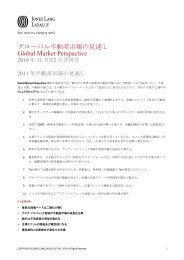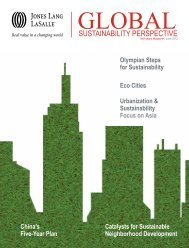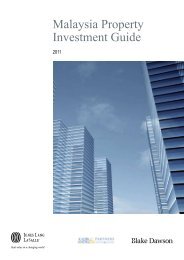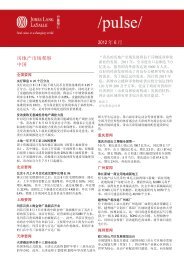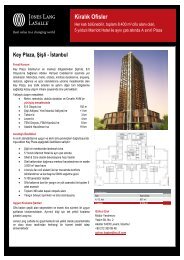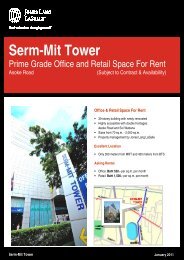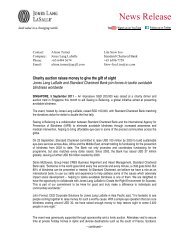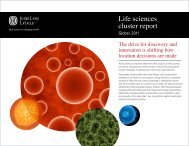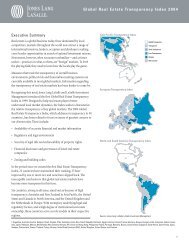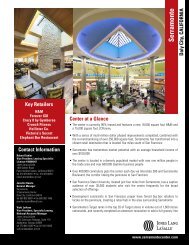Global Trends in Sustainable Real Estate - Jones Lang LaSalle
Global Trends in Sustainable Real Estate - Jones Lang LaSalle
Global Trends in Sustainable Real Estate - Jones Lang LaSalle
Create successful ePaper yourself
Turn your PDF publications into a flip-book with our unique Google optimized e-Paper software.
<strong>Global</strong> <strong>Trends</strong> <strong>in</strong> Susta<strong>in</strong>able <strong>Real</strong> <strong>Estate</strong>: An Occupier’s Perspective – February 2008<br />
Figure 2: Expectations as to when susta<strong>in</strong>ability will<br />
become a critical bus<strong>in</strong>ess and CRE issue.<br />
Number of respondents<br />
180<br />
160<br />
140<br />
120<br />
100<br />
80<br />
60<br />
40<br />
20<br />
0<br />
It's already<br />
critical<br />
With<strong>in</strong> 1-2<br />
years<br />
With<strong>in</strong> 3<br />
years<br />
With<strong>in</strong> 5<br />
years<br />
More than 5<br />
years<br />
Time until susta<strong>in</strong>ability becomes critical bus<strong>in</strong>ess issue<br />
Table 1: When will susta<strong>in</strong>ability be a critical bus<strong>in</strong>ess<br />
issue to corporate real estate?<br />
EMEA<br />
North<br />
America<br />
Asia Australasia<br />
Critical Now 62% 44% 42% 52%<br />
Critical with<strong>in</strong> 1- 2 years 23% 35% 20% 23%<br />
This is likely due to the diversity of property market cycles<br />
with<strong>in</strong> the Asia region and difference <strong>in</strong> susta<strong>in</strong>ability drivers<br />
across these markets. In addition, the Asia survey was<br />
undertaken <strong>in</strong> March 2007, and susta<strong>in</strong>ability is an issue that<br />
experienced significant growth <strong>in</strong> momentum throughout the<br />
year right across the region.<br />
We are see<strong>in</strong>g a significant push towards susta<strong>in</strong>ability <strong>in</strong> many<br />
countries <strong>in</strong> Asia. Ch<strong>in</strong>a, India and S<strong>in</strong>gapore are three<br />
countries attempt<strong>in</strong>g to improve susta<strong>in</strong>able real estate<br />
development through revis<strong>in</strong>g standards and policies. In<br />
S<strong>in</strong>gapore, the government is be<strong>in</strong>g able to drive susta<strong>in</strong>ability<br />
effectively and strongly due to its small size and culture. While<br />
the more mature S<strong>in</strong>gapore market is mak<strong>in</strong>g <strong>in</strong>-roads <strong>in</strong><br />
commercialis<strong>in</strong>g susta<strong>in</strong>ability, there is noth<strong>in</strong>g <strong>in</strong> S<strong>in</strong>gapore<br />
equivalent <strong>in</strong> scale and scope to the major susta<strong>in</strong>able<br />
developments go<strong>in</strong>g on <strong>in</strong> Ch<strong>in</strong>a and India now. India has one<br />
of the first LEED rated build<strong>in</strong>gs <strong>in</strong> Asia and Olympia<br />
Technology Park <strong>in</strong> Chennai, which has achieved a LEED Gold<br />
Rat<strong>in</strong>g, has been identified as the world’s largest green<br />
build<strong>in</strong>g. 2 Ch<strong>in</strong>a is build<strong>in</strong>g the world’s first eco-city <strong>in</strong> Dongtan,<br />
anticipated for completion <strong>in</strong> 2010. At the same time, there are<br />
also other large-scale susta<strong>in</strong>able developments enter<strong>in</strong>g the<br />
plann<strong>in</strong>g stage <strong>in</strong> Ch<strong>in</strong>a.<br />
2 LEED is a Green Build<strong>in</strong>g Rat<strong>in</strong>g System developed by the US Green Build<strong>in</strong>g<br />
Council which provides a suite of standards for environmentally susta<strong>in</strong>able<br />
construction.<br />
Never<br />
3 COPYRIGHT © JONES LANG LASALLE IP, INC. 2007. All rights reserved.<br />
Those occupiers at the vanguard of susta<strong>in</strong>ability are typically<br />
global <strong>in</strong> orientation and are appraised on a global basis. They<br />
are br<strong>in</strong>g<strong>in</strong>g demands for susta<strong>in</strong>able real estate to the fore<br />
across Asia. Develop<strong>in</strong>g markets have a significant opportunity<br />
to cater to these requirements by <strong>in</strong>troduc<strong>in</strong>g susta<strong>in</strong>ability<br />
<strong>in</strong>itiatives <strong>in</strong> new build<strong>in</strong>gs due to the higher level of new<br />
development compared to exist<strong>in</strong>g stock on the market.<br />
Develop<strong>in</strong>g markets <strong>in</strong> Asia have a real opportunity to<br />
implement susta<strong>in</strong>ability <strong>in</strong>itiatives as an <strong>in</strong>tegral part of a<br />
country’s real estate development. This could ultimately lead to<br />
a higher level of susta<strong>in</strong>able stock available across the market.<br />
More mature markets will need to focus on implement<strong>in</strong>g<br />
susta<strong>in</strong>ability improvements <strong>in</strong> exist<strong>in</strong>g stock to cater for<br />
demand.<br />
The urgent and critical focus upon susta<strong>in</strong>ability is<br />
understandable when one considers the exposure that real<br />
estate represents to a corporate. Typically 50% of all energy<br />
and as much as a third of all water is consumed <strong>in</strong> commercial<br />
real estate, mean<strong>in</strong>g that the performance of real estate has a<br />
direct and immediate impact on an occupier’s ability to reduce<br />
its carbon footpr<strong>in</strong>t and environmental degradation.<br />
Accord<strong>in</strong>gly, <strong>in</strong> publicis<strong>in</strong>g their susta<strong>in</strong>ability credentials and<br />
<strong>in</strong>tentions public through CSR statements, occupiers have to<br />
prioritise the issues surround<strong>in</strong>g green real estate. It is little<br />
wonder therefore that the development of susta<strong>in</strong>able real<br />
estate is either critical or near critical for many of the world’s<br />
lead<strong>in</strong>g occupiers. This trend will cont<strong>in</strong>ue to <strong>in</strong>tensify over the<br />
short to medium term particularly as <strong>in</strong>itial trailblazers provide<br />
evidence of f<strong>in</strong>ancial and non-f<strong>in</strong>ancial out-performance through<br />
the adoption of clear susta<strong>in</strong>ability strategies.<br />
Figure 3: Susta<strong>in</strong>ability – an organisational threat or<br />
opportunity?<br />
Number of respondents<br />
250<br />
200<br />
150<br />
100<br />
50<br />
0<br />
0<br />
10<br />
50<br />
Major threat M <strong>in</strong>or threat Neither threat<br />
nor opportunity<br />
92<br />
M<strong>in</strong>or<br />
opportunity<br />
207<br />
Major<br />
opportunity<br />
Encourag<strong>in</strong>gly, and as Figure 3 shows, occupiers regard issues<br />
surround<strong>in</strong>g susta<strong>in</strong>ability as an opportunity rather than a threat.<br />
Occupiers <strong>in</strong> EMEA and Australasia are the most opportunistic,<br />
with 87% of respondents from each region regard<strong>in</strong>g<br />
susta<strong>in</strong>ability as an opportunity and more than 60% <strong>in</strong> both<br />
regions regard<strong>in</strong>g the issue as a ‘major opportunity’.



